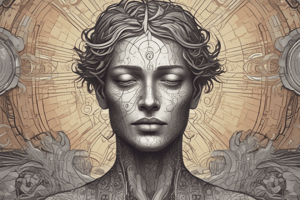Podcast
Questions and Answers
What is the risk of developing schizophrenia if one identical twin has the condition?
What is the risk of developing schizophrenia if one identical twin has the condition?
- 50% (correct)
- 75%
- 35%
- 15%
What is a possible explanation for the decreased brain tissue and cerebrospinal fluid in people with schizophrenia?
What is a possible explanation for the decreased brain tissue and cerebrospinal fluid in people with schizophrenia?
- A result of poor nutrition and lack of exercise
- A subsequent loss of tissue due to aging
- A failure in the development of brain tissue (correct)
- A genetic mutation that affects brain growth
What is the risk of developing schizophrenia if both biological parents have the condition?
What is the risk of developing schizophrenia if both biological parents have the condition?
- 25%
- 15%
- 35% (correct)
- 10%
What is a possible cause of the brain pathology found in people with schizophrenia?
What is a possible cause of the brain pathology found in people with schizophrenia?
What are the two neurochemicals involved in prominent theories of schizophrenia?
What are the two neurochemicals involved in prominent theories of schizophrenia?
Flashcards are hidden until you start studying
Study Notes
Introduction to Schizophrenia
- Schizophrenia is a serious, chronic, psychiatric disorder characterized by impaired reality testing, hallucinations, delusions, and limited socialization.
- It is a psychotic thought disorder where hallucinations and delusions dominate the patient's thinking, leading to confusing and bizarre behaviors.
- People with schizophrenia have a disconnection between their thoughts and feelings and between their reality and society's reality, leading to unusual and frightening behaviors.
Characteristics of Schizophrenia
- Schizophrenia is a frequent cause of long psychiatric hospitalizations.
- The suffering of patients with schizophrenia and their families can last a lifetime as this crippling condition continues.
- The first psychotic break often responds well to treatment, but the relapse rate is high, and the person may become increasingly disabled.
- Schizophrenic individuals are vulnerable to substance abuse as they self-medicate to control their symptoms.
- These patients can also be at risk for suicide, which may be manifested as voices telling the person to kill themselves or a means to end suffering.
Schizophrenia Spectrum Disorders
- DSM-5 now categorizes schizophrenia under the global title of schizophrenia spectrum disorders (2013).
- The new term of schizophrenia spectrum disorders reflects a gradient of psychopathology that a patient can experience from least to most severe.
- Disorders such as schizophreniform and schizoaffective would be the less severe forms.
- Psychoses can occur in bipolar disorder and major depression.
- Another psychotic disorder is brief psychotic disorder, which includes postpartum psychosis as well as psychosis due to substance abuse or medical conditions.
Diagnosis and Prevalence
- Schizophrenia is usually diagnosed in late adolescence or early adulthood.
- The peak incidence of onset is 15 to 25 years of age for men and 25 to 35 years of age for women.
- The prevalence of schizophrenia is estimated at about 1% of the population.
- Most clients slowly and gradually develop signs and symptoms such as social withdrawal, unusual behavior, loss of interest in school or work, and neglected hygiene.
Types of Schizophrenia
- DSM-5 eliminated the subtypes of catatonic, delusional, disorganized, undifferentiated, and residual.
- The new term of schizophrenia spectrum disorders reflects a gradient of psychopathology that a patient can experience from least to most severe.
Symptoms of Schizophrenia
- The presence of delusions, hallucinations, and/or disorganized speech for a significant portion of time during a 1-month period.
- Grossly abnormal motor behavior and/or negative symptoms.
- One or more areas of functioning, such as school, work, personal relationships, or self-care, are impaired.
- Some disturbance needs to be evident for at least 6 months.
Long-Term Course
- The intensity of psychosis tends to diminish with age.
- Many clients with long-term impairment regain some degree of social and occupational functioning.
- Over time, the disease becomes less disruptive to the person's life and easier to manage, but rarely can the client overcome the effects of many years of dysfunction.
- In later life, these clients may live independently or in a structured family-type setting and may succeed at jobs with stable expectations and a supportive work environment.
Related Disorders
- Schizoaffective disorder: diagnosed when the client is severely ill and has a mixture of psychotic and mood symptoms.
- Schizophreniform disorder: the client exhibits an acute, reactive psychosis for less than 6 months.
- Catatonia: characterized by marked psychomotor disturbance, either excessive motor activity or virtual immobility and motionlessness.
- Delusional disorder: the client has one or more non-bizarre delusions, and psychosocial functioning is not markedly impaired.
Biologic Theories
- Genetic factors: twin studies show that identical twins have a 50% risk, and fraternal twins have a 15% risk of schizophrenia.
- Neuroanatomic and neurochemical factors: people with schizophrenia have relatively less brain tissue and cerebrospinal fluid, and computed tomography scans have shown enlarged ventricles in the brain and cortical atrophy.
- Neurochemical theories: dopamine and serotonin imbalance may contribute to the development of schizophrenia.
Studying That Suits You
Use AI to generate personalized quizzes and flashcards to suit your learning preferences.




